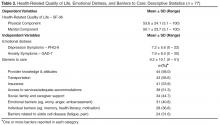Results
Demographic and Clinical Characteristics
Table 1 shows the demographic characteristics of the 77 participating adults with SCD. Sixty percent were female. Patients ranged in age from 18 to 69 years, with a mean age of 31.6 (SD = 13.1) years. Consistent with the general SCD population, participants were predominantly black/African American. Over 66% of families reporting had a median household income of less than $30,000 annually, although the mean household size was 3 to 4 persons. The majority of the participants (57%) had some college and beyond, although 14% had not completed high school. Over 80% of participants were on public insurance.
The majority of patients (73%) were diagnosed with Hgb SS disease and the most common lifetime complication was pain, reported by almost all of participants (Table 1). The next most common complication was fever, followed by acute chest syndrome. Twenty-seven percent of participants were currently on the disease-modifying therapy hydroxyurea, while 61% had a lifetime history of transfusion therapy. These data were verified with information from the clinical database for 73 participants (95%).
The median number of ED visits in the previous year was 1 (range, 0–50), with 19 patients (25%) with zero visits. The median number of hospital days in the previous year was 13 (range, 0–81). Twenty-nine patients (38%) had no hospital days in the previous year. These data were verified with information from the clinical database for 53 participants (69%), since hospital and ED visits occurred at institutions not always linked with the clinical databases at the sponsoring hospitals.
Emotional Distress, Barriers to Care, and Health-Related Quality of Life
The mean score for the sample on the PHQ-9 was 7.2 (SD = 5.6, α = 0.86, Table 2 ). The prevalence of moderate to severe symptoms of depression (ie, scores ≥ 10) was 33% ( n = 25). Twelve patients with moderate to severe symptoms (48%) reported that symptoms of depression created some difficulty in work, daily activities, or relationships, while 10 patients (40%) reported very much to extreme difficulty in work, daily activities, or relationships due to depression symptoms.The mean score on the GAD-7 was 7.9 (SD = 6.0, α = 0.90, Table 2). The prevalence of moderate to severe symptoms of anxiety (scores ≥ 10) was 36.4% ( n = 28). Fourteen patients with moderate to severe symptoms (50%) reported that anxiety symptoms created some difficulty in work, daily activities, or relationships. Twelve patients (43%) reported that symptoms created very much to extreme difficulty in work, daily activities, or relationships. Fifteen patients (29%) with moderate to severe symptoms of anxiety or depression exhibited comorbid anxiety and depression.
The mean Physical Component Summary score on the SF-36 was 53.6 (SD = 24.1, α = 0.94, Table 2). The prevalence of impaired to very impaired HRQL in the physical domain was 17% ( n = 13). The mean Mental Component Summary score on the SF-36 for the sample was 50.1 (SD = 23.7, α = 0.93), with a prevalence of 16% ( n = 12) in the impaired to very impaired range for HRQL in the mental domain.


